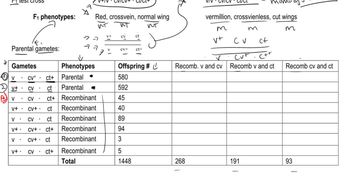Table of contents
- 1. Introduction to Genetics51m
- 2. Mendel's Laws of Inheritance3h 37m
- 3. Extensions to Mendelian Inheritance2h 41m
- 4. Genetic Mapping and Linkage2h 28m
- 5. Genetics of Bacteria and Viruses1h 21m
- 6. Chromosomal Variation1h 48m
- 7. DNA and Chromosome Structure56m
- 8. DNA Replication1h 10m
- 9. Mitosis and Meiosis1h 34m
- 10. Transcription1h 0m
- 11. Translation58m
- 12. Gene Regulation in Prokaryotes1h 19m
- 13. Gene Regulation in Eukaryotes44m
- 14. Genetic Control of Development44m
- 15. Genomes and Genomics1h 50m
- 16. Transposable Elements47m
- 17. Mutation, Repair, and Recombination1h 6m
- 18. Molecular Genetic Tools19m
- 19. Cancer Genetics29m
- 20. Quantitative Genetics1h 26m
- 21. Population Genetics50m
- 22. Evolutionary Genetics29m
4. Genetic Mapping and Linkage
Crossing Over and Recombinants
Problem 13
Textbook Question
You have isolated (1) a streptomycin-resistant mutant (strᴿ) of Chlamydomonas that maps to the chloroplast genome and (2) a hygromycin-resistant mutant (hygᴿ) of Chlamydomonas that maps to the mitochondrial genome. What types of progeny do you expect from the following reciprocal crosses?
mt⁺ strᴿ hygˢ× mt⁻ strˢ hygᴿ
mt⁺ strˢ hygᴿ× mt⁻ strᴿ hygSˢ
 Verified step by step guidance
Verified step by step guidance1
Understand the genetic basis of the problem: Streptomycin resistance (strᴿ) is encoded in the chloroplast genome, while hygromycin resistance (hygᴿ) is encoded in the mitochondrial genome. Chloroplast and mitochondrial genomes are inherited uniparentally in Chlamydomonas, with the chloroplast genome inherited from the mt⁺ parent and the mitochondrial genome inherited from the mt⁻ parent.
Analyze the first cross: mt⁺ strᴿ hygˢ × mt⁻ strˢ hygᴿ. Since the chloroplast genome is inherited from the mt⁺ parent, the progeny will inherit the strᴿ allele. The mitochondrial genome is inherited from the mt⁻ parent, so the progeny will inherit the hygᴿ allele.
Predict the progeny phenotype for the first cross: All progeny will be streptomycin-resistant (strᴿ) due to the chloroplast inheritance from the mt⁺ parent and hygromycin-resistant (hygᴿ) due to the mitochondrial inheritance from the mt⁻ parent.
Analyze the second cross: mt⁺ strˢ hygᴿ × mt⁻ strᴿ hygˢ. In this case, the chloroplast genome is inherited from the mt⁺ parent, so the progeny will inherit the strˢ allele. The mitochondrial genome is inherited from the mt⁻ parent, so the progeny will inherit the hygˢ allele.
Predict the progeny phenotype for the second cross: All progeny will be streptomycin-sensitive (strˢ) due to the chloroplast inheritance from the mt⁺ parent and hygromycin-sensitive (hygˢ) due to the mitochondrial inheritance from the mt⁻ parent.
 Verified video answer for a similar problem:
Verified video answer for a similar problem:This video solution was recommended by our tutors as helpful for the problem above
Video duration:
5mPlay a video:
Was this helpful?
Key Concepts
Here are the essential concepts you must grasp in order to answer the question correctly.
Chloroplast and Mitochondrial Genetics
Chloroplasts and mitochondria are organelles with their own genomes, which are inherited maternally in many organisms. In Chlamydomonas, mutations in these genomes can lead to resistance to specific antibiotics, such as streptomycin and hygromycin. Understanding how these organelles contribute to inheritance patterns is crucial for predicting progeny outcomes in genetic crosses.
Recommended video:
Guided course

Organelle Inheritance
Reciprocal Crosses
Reciprocal crosses involve mating two different strains in both possible combinations to assess the inheritance of traits. This method helps determine whether traits are linked to specific parental genotypes and can reveal the effects of maternal versus paternal contributions to progeny. Analyzing the results of these crosses is essential for understanding the genetic basis of the observed traits.
Recommended video:
Guided course

Trihybrid Cross
Antibiotic Resistance Mechanisms
Antibiotic resistance in organisms like Chlamydomonas can arise from mutations in specific genes within the chloroplast or mitochondrial genomes. These mutations can confer the ability to survive in the presence of antibiotics, which is a key factor in determining the phenotypes of progeny from genetic crosses. Recognizing how these resistance traits are inherited is vital for predicting the outcomes of the crosses described in the question.
Recommended video:
Guided course

R Plasmid
Related Videos
Related Practice
Textbook Question
Why are double-crossover events expected less frequently than single-crossover events?
1206
views
1
rank


